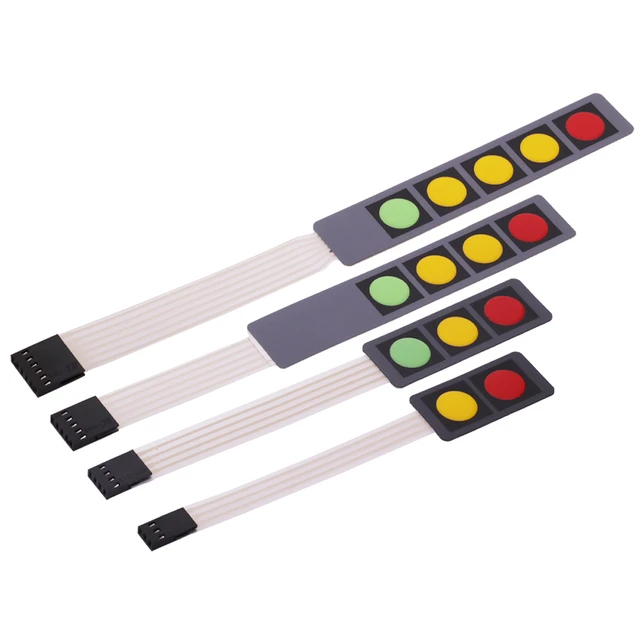Understanding Membrane Layer Switches: The Trick to Trustworthy and long lasting Controls

What Are Membrane Buttons?
Membrane layer buttons are a sophisticated solution in the realm of customer interface technology, integrating performance and style effortlessly. These devices work as an interface in between users and digital systems, incorporating several parts right into a portable format. Usually built from flexible, thin layers of materials, membrane layer switches are created to respond to touch, allowing individuals to interact with machinery and digital devices effectively.
The primary elements of a membrane switch consist of a published circuit layer, graphic overlay, and a spacer layer that avoids unintentional activation. The graphic overlay can be personalized to mirror brand name identification or customer choices, boosting visual appeals while making sure use. Membrane switches are commonly made use of in numerous applications, including clinical gadgets, customer electronic devices, and commercial equipment, owing to their toughness and resistance to environmental aspects such as moisture and dirt.
One of the crucial benefits of membrane layer buttons is their ability to hold up against wear and tear, making them excellent for high-traffic environments. In addition, they are lightweight and call for marginal space, permitting innovative styles in item advancement. Overall, membrane layer switches over stand for a useful and efficient choice for modern-day digital interfaces, weding technology with user-centric design concepts.
Just How Membrane Switches Over Work
The operation of membrane switches over joints on a straightforward yet effective system that equates user input right into digital signals. When an individual presses the switch, the leading layer warps, allowing a conductive component in the circuit layer to make contact with an equivalent conductive pad on the bottom of the graphic overlay.
The style of membrane layer switches can vary, yet they often integrate domes or responsive elements to supply comments to the customer, boosting the overall experience - membrane switch. The materials made use of in membrane switches, such as polyester or polycarbonate, add to their resilience and resistance to ecological aspects, consisting of dampness and dirt. In addition, the printed circuits are typically encapsulated, which secures them from deterioration in time.
Advantages of Membrane Switches

Furthermore, membrane layer switches are understood for their toughness. Created from robust products, they are resistant to dirt, dampness, and physical wear, which substantially prolongs their life expectancy contrasted to conventional mechanical switches. This toughness makes them specifically suitable for high-traffic settings and applications requiring long life.
Another substantial benefit is the ease of cleaning and maintenance. The smooth surface area of membrane layer switches reduces dirt accumulation and is often unsusceptible spills, making them ideal for setups that need frequent sanitization.
In addition, membrane layer switches use a structured account, causing a thinner layout that can be integrated right into different gadgets without including mass. This feature not just enhances the aesthetic allure but also contributes to an extra ergonomic item style.
Applications of Membrane Layer Switches
Functional and easy to use, membrane layer switches find applications across a vast range of sectors, consisting of clinical tools, consumer electronic devices, and industrial equipment. In the clinical area, these switches are indispensable to tools such as analysis devices, client monitoring click for source systems, and infusion pumps, where reliability and simplicity of cleaning are important. Their ability to withstand rough atmospheres and preserve performance makes them ideal for such applications.

In customer electronics, membrane layer buttons are used in products like microwaves, cleaning devices, and remotes - membrane switch. Their sleek design enables user-friendly interface, boosting the general individual experience while providing durability and resistance to deterioration
Industrial tools also takes advantage of membrane layer buttons, especially in control panels for equipment and automation systems. These switches offer protection versus dust and dampness, ensuring regular efficiency in tough settings. Additionally, their customizable functions allow manufacturers to tailor them to details operational demands, improving efficiency and capability.
Picking the Right Membrane Switch
When selecting a membrane layer switch, it is important to think about numerous factors that affect efficiency and suitability for particular applications. The main considerations include ecological conditions, responsive responses, resilience, and layout specs.
First, assess the operating atmosphere; switches revealed to wetness, chemicals, or severe temperature levels need specific materials to make certain long life and performance. Next, assess the demand for responsive feedback. Relying on customer interaction, some applications might profit from a responsive reaction to verify activation, while others may prefer a non-tactile layout other for aesthetic factors.
Durability is one more important factor; membrane layer buttons should be created to withstand regular usage, effects, and abrasion. Make certain the chosen button can sustain the anticipated lifecycle, especially in high-usage circumstances.

Conclusion
In verdict, membrane layer switches over offer as crucial elements in the layout of dependable and resilient control systems across numerous industries. The flexibility continue reading this of membrane layer switches over enables for customized solutions that fulfill details functional requirements, strengthening their significance in modern-day innovation.
Membrane layer switches over stand for a critical element of contemporary user interface layout, blending capability with resilience in various applications.Membrane layer buttons are an innovative remedy in the realm of customer interface innovation, combining capability and design flawlessly. Commonly constructed from adaptable, slim layers of materials, membrane switches are designed to respond to touch, allowing individuals to interact with machinery and electronic tools effectively.
The style of membrane buttons can vary, but they frequently include domes or tactile aspects to provide responses to the individual, improving the overall experience.In verdict, membrane switches over serve as crucial components in the layout of sturdy and reputable control systems throughout numerous industries.